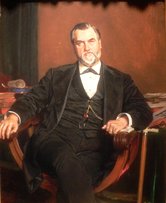Post Civil War US

In the period 1870-1900, the United States faced intense urban and industrial growth accompanied with economic and social instability. After the Civil War, the urban workforce had multiplied in order to keep apace with the growth in industry; however, cities were not adequately equipped to accommodate the 27,000,000 white immigrants that by and large arrived from Eastern Europe and Russia (# 1 p. 886, #2 p. 97). Unemployment fluctuated, businesses went bankrupt, and the price of goods was in a constant state of oscillation (#4 p. 886). These transformations rendered a rise in dependency, delinquency, and pauperism, as just a few of the perceived social ills (#3 p. 2). As a response to these conditions, various leagues and religious institutions attempted to alleviate social problems through charity work.
Despite all these problems, this period was also known as the Gilded Age because of the rapid economic and industrial expansion.There was a rise of a new, wealthy, industrial class that rubbed elbows against the traditional aristocracy. Many members of the traditional elite scorned those with new wealth and claimed that they lacked refined social etiquette (#4 p. 41). Tension arose between the new elite's emulation of aristocratic social forms and the need for the old elite to distinguish themselves through their inherited social privilege (#4 p. 43). However, these newcomers were inevitably incorporated into the elite social order by the end of the nineteenth century (#4 p. 55).
Despite all these problems, this period was also known as the Gilded Age because of the rapid economic and industrial expansion.There was a rise of a new, wealthy, industrial class that rubbed elbows against the traditional aristocracy. Many members of the traditional elite scorned those with new wealth and claimed that they lacked refined social etiquette (#4 p. 41). Tension arose between the new elite's emulation of aristocratic social forms and the need for the old elite to distinguish themselves through their inherited social privilege (#4 p. 43). However, these newcomers were inevitably incorporated into the elite social order by the end of the nineteenth century (#4 p. 55).
Progressive Movement

Leland Stanford
Progressives believed that “modern society must be planned and rationalized according to modern principles of biology, sociology, and economics” and called for increased governmental control in people’s lives. A core component of progressivism was that the United States need to shift from laissez-faire capitalism to government managed capitalism. At first, many businessmen, government employees, and the wealthy did not accept this idea of managed capitalism; however, gradually the elite began to embrace greater scientific management as the solution to economic and social problems. The emphasis on greater management led to a new managerial class composed of educated, middle class experts (#1 p. 886).
The new elite that emerged during the Gilded Age relied heavily on the advice of this educated, managerial class. In fact, the new elite not only relied on this new educated class of people, but also founded the institutions to train this class of experts. New industrialist like Leland Stanford, Andrew Carnegie, Ezra Cornell, and Johns Hopkins founded institutions that were designed to inculcate a more science-oriented curriculum rather than the traditional curriculum of Greek, Latin, mathematics, and moral philosophy. The new elite developed these institutions to equip students with the ability to succeed in business, agriculture, and the sciences (#4 p.61). Soon, these institutions became the purveyors of social privilege and dictated a radically new type of inheritance distinct from hereditary privilege of the old aristocracy. In this context, corporate inheritance dictated social status and was based on success through competition as an indicator of one's natural ability of leadership. While kinship inheritance never disappeared, this period marked a transition in which admission and reproduction of social privilege were based more on the institutional training (#4 p. 67-69).
The new elite that emerged during the Gilded Age relied heavily on the advice of this educated, managerial class. In fact, the new elite not only relied on this new educated class of people, but also founded the institutions to train this class of experts. New industrialist like Leland Stanford, Andrew Carnegie, Ezra Cornell, and Johns Hopkins founded institutions that were designed to inculcate a more science-oriented curriculum rather than the traditional curriculum of Greek, Latin, mathematics, and moral philosophy. The new elite developed these institutions to equip students with the ability to succeed in business, agriculture, and the sciences (#4 p.61). Soon, these institutions became the purveyors of social privilege and dictated a radically new type of inheritance distinct from hereditary privilege of the old aristocracy. In this context, corporate inheritance dictated social status and was based on success through competition as an indicator of one's natural ability of leadership. While kinship inheritance never disappeared, this period marked a transition in which admission and reproduction of social privilege were based more on the institutional training (#4 p. 67-69).
